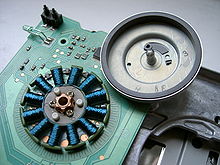Spindle motor

The spindle motor is an electric motor , the task of which is to set a spindle in rotation.
Conventional electric motors that drive a spindle (a threaded spindle is often referred to), axes, working shafts or other processing components of a machine (see also motor spindle ) are often referred to as spindle motors. However, there is not only one linguistic difference, because the English expression “spindle motor” does not match the German expression. The English term is an electronically commutated DC motor that was developed exclusively to drive hard drives .
designation
An electrically commutated motor is called a spindle motor and is used in most cases as a direct drive (see electric motor ). The term spindle motor probably comes from the textile industry: There, electric motors drive and still drive the spindles of looms or other spindles in textile machines directly. In addition, it can be assumed that the term has its origin in mechanical engineering; For example, the axes of a CNC machine are called spindles. The drive provided for this is usually an electric motor, so to speak a "spindle motor" with special properties.
The English term “spindle motor” originated in the hard disk industry. The designation "spindle motor" is mentioned for the first time in a European patent specification that was filed with the European Patent Office in 1990. In the same year, a US patent named “Disk Spindle Motor”. Up to this point in time, the motor and spindle were each characterized as separate components. In the early days of hard disk drives, the disks - the round storage disks - were mounted on a shaft, which is also known as a “spindle” or “shaft”, one above the other or, because of their enormous weight, side by side. This spindle with the storage disks was set in rotation via a belt that was coupled to an “ordinary” electric motor. The initial electric motor and the spindle were continuously developed until both components merged into one unit. From then on, the English term “spindle motor” was used to denote hard disk drives.
Development of engine bearings
Earlier hard disk drives were massive, heavy systems, most of which had a short service life and limited speeds. In addition, ball bearings were built into the hard disk drives, which were subject to high wear and tear and made enormous noises.
In order to meet the growing demand for hard drives, companies such as PMDM- Minebea , Nidec , IBM , Matsushita , JVC , Daiichi Sankyō , Philips and TDK continued to develop the drives. Today there are still four large manufacturers of hard disk motors - in addition to Nidec and PMDM Minebea, Alphana and Samsung (sold to Seagate ) - who share the world market among themselves. The production capacities are between 5 million and 25 million engines per month. Thanks to the development of new types of bearing systems, it was possible for the first time to make the motors smaller and to drastically increase their service life and performance.
Today's hard disk motors no longer have ball bearings , but rather fluid- mounted bearings , so-called fluid dynamic bearings (FDB). They run extremely smoothly and run precisely, have a comparatively low noise level and a long service life, since mechanical wear has been minimized and only low bearing oil evaporation occurs, and they enable high speeds (up to 15,000 revolutions per minute). Hard disk motors with liquid bearings are used today in all sizes of mechanical hard disks.
Because of their compact design and high efficiency, motors that are similar in structure to hard disk motors are increasingly being used outside of the hard disk industry, for example for industrial machinery and automotive applications.
Manufacture of hard disk motors
The hard disk drive consists of many filigree components, the tolerances of which can now be found in the nanometer range. That is why they have to be joined, pressed or glued in clean rooms.
Patents
- United States Patent Number: 5,155,640
- UK Patent GB 2231372A, Application 8910940.9
- U.S. Patent 4,011,589
- EU patent 90113790.1, 1990
Web links
- Article on hard drive motors (English)

